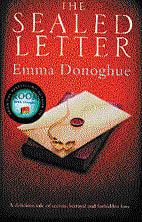
The Sealed
Letter
Emma Donoghue
Picador
2011, pp 396
Rs 499
It’s a compliment to Emma Donoghue’s writing skills that after reading the 400-odd pages of this book, set in the Victorian era and narrated in the language of the time, it’s disorienting to read her own (quite modern-sounding) voice in the afterword, to find out that she doesn’t normally talk in that stilted fashion.
But then an afterword was quite necessary to set the context for such a book. The Sealed Letter is a fictionalised account of one of the early well-publicised divorce cases in England. While the book focusses almost entirely on the events of the case, the postscript serves to set the characters in their place in history.
The story is told mostly through the eyes of Emily ‘Fido’ Faithfull, a pioneering British women’s rights activist and publisher. As the book starts off in 1868, Fido runs into an old friend of hers, seemingly out of the blue. Helen Codrington was away from England for many years, but has now returned.
It doesn’t take long for her to insinuate herself back in Fido’s life. Fido notices that Helen is often accompanied on her shopping excursions by an army officer, Col Anderson, who seems to have a crush on the older Helen. But as the days go by, Fido realises that the affection is mutual. Anderson and Helen are having an affair, and she, Fido, has been drawn into keeping the secret from Helen’s husband, Admiral Henry Codrington.
Codrington eventually comes to know about his wife’s affair. It has just been a few years since divorce became something possible and affordable for the common man in England — the law permitting it was passed in 1857. Before this, it required an act of parliament. Codrington, thus, decides to use the law and free himself from his wife.
Helen, of course, plans her own countermoves to get as much as possible out of the relationship. Some of the discussions related to the subject of divorce here seem astonishingly contemporary — human relationships, after all, don’t change through the years.
Donoghue wisely never blames the breakup of the marriage on either husband or wife — the points of view of both are given space, and we never see the origins of the rift. She focusses on the telling of the divorce, mostly based on the newspaper accounts of the time. There are lots of these reports available, because the case turned into a media circus, with
reporters thronging the courts and publishing sensational stories everyday.
The case itself has several twists and turns, one of the most interesting being the titular sealed letter. The letter is concocted in Codrington’s lawyers’ chambers as a ruse to lure a reticent witness onto the stand. But even apart from the letter, we have turncoat witnesses, veiled visitors in the courtroom, unexpectedly lurid testimony, heartbreak and shock — in short, all the ingredients of a modern-day legal novel.
Above all, Donoghue has a few further surprises up her sleeve: she’s taken a few liberties with the real life characters and added some secrets to change our perception of them. She’s also compressed the timeline of the story from a few years to a couple of months in order to keep the momentum going. But all these touches serve to improve the book.
The central character of the book, in many ways, is Helen Codrington. She’s drawn as a mostly unsympathetic woman, someone with no qualms about manipulating those around her, and looking to gain sympathy and favour from any avenue. However, one can’t help but be struck by her pragmatism in looking for happiness — as she herself says, “You always thought of me as an Emma Bovary, when the truth was much simpler — I took my fun where I found it.” There are points where we see she has genuine emotions — in her love for her children, for example, but this is always overlaid with her manipulative instinct. Her eventual fate, as revealed in the author’s postscript, adds a poignant note to the story.
Fido, on the other hand, is the emotional core, leading the reader through the various layers of the case. Her preoccupation with women’s rights makes for a good counterpoint to the case — neither Harry nor Helen seem sympathetic to her cause, even though they are of very different natures. She becomes a critical witness in the divorce case, and with the swinging of her sympathies, the reader’s sympathises swing as well.
Emma Donoghue is best known for her latest book, Room, which was
shortlisted for the Booker prize last year. The Sealed Letter, which was her previous publication, seems better fitted to her background: she’s a literary historian, and focusses on women’s rights and relationships.
More than being a view into the Victorian era, or a chronicle of a pioneering legal case, The Sealed Letter succeeds as a human document.